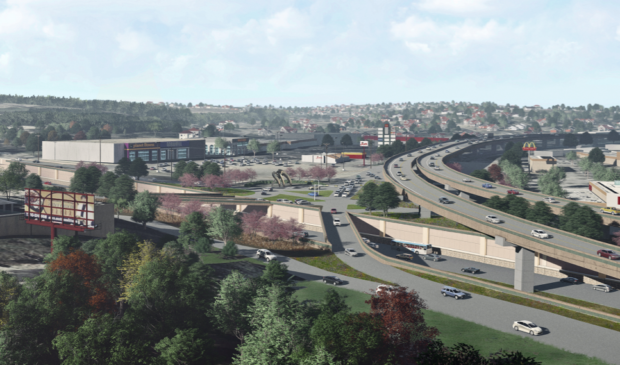Advocates continue fighting for alternative solution to Oak Hill Parkway
Tuesday, July 16, 2019 by
Ryan Thornton While the Texas Department of Transportation prepares to initiate a request for proposals for the Oak Hill Parkway project at the intersection of U.S. Highway 290 and State Highway 71, local advocacy groups are still aiming to stop the project from moving ahead in its current form.
On July 9, the Save Barton Creek Association, with signatures from 13 other local groups, sent a letter urging James Bass, executive director of TxDOT, and Tucker Ferguson, engineer of the TxDOT Austin District, to take another look at the plan and consider alternative designs that the groups say would benefit the Oak Hill community while mitigating the project’s environmental impact.
The Oak Hill Parkway project was added to the Capital Area Metropolitan Planning Organization 2019-2022 Transportation Improvement Program in a unanimous vote on Jan. 14. It was then granted over $3 million in dedicated right-of-way purchases and relocation of reimbursable utility funds by the Austin City Council at the end of January.
Environmental groups and concerned residents articulated numerous issues with the project prior to both votes, asking both CAMPO and Council to push back against the state’s plans. Among the many objections, residents have repeatedly pushed to downsize the elevated 12-lane junction, citing potential hazards to the nearby Barton Springs/Edwards Aquifer, Williamson Creek and the Oak Hill neighborhood.
Other citizens expressed frustration that the design had changed very little since the initial plans for a toll road were scrapped. Like the previous toll road design, many argued that this project is directly contrary to the city’s goals for multimodal transportation, traffic safety and the Oak Hill community. In contrast, a number of groups advocated for an at-grade multimodal parkway design, known as the Livable Oak Hill plan, created by local urban planner Daniel Alvarado.
The joint letter re-emphasizes all of these issues and directs attention to the fact that the state has continued to make adjustments to the project design, despite the final environmental impact statement and record of decision having been issued in December 2018. The letter says that following the EIS, changes have been made to the number of lanes, the shared-use path and the flood risk modeling. “These are all items that should be included within the (environmental impact statement) process,” the letter states.
Believing the EIS to be incomplete, Save Barton Creek hired the services of Jeffrey Appel, an attorney with Utah-based firm Ray Quinney & Nebeker, to review the process and provide any necessary negotiation efforts. Though that review is still ongoing, Appel sent Save Barton Creek a letter at the end of January highlighting a number of initial concerns to be explored further.
Citing a Jan. 25 letter to Council by environmental advocate and researcher Bruce Melton, Appel agrees with Melton’s fundamental conclusion that CAMPO’s growth predictions have consistently been overestimated for the past three decades. Due to that miscalculation, Melton said, the state still needs to demonstrate the need for the project before anything else.
Terry McCoy, an engineer with the TxDOT Austin District, responded to Melton’s analysis in January, stating that his critique is meaningless since the region’s traffic growth predictions have been based on the potential capacity following construction of a new freeway. That growth, McCoy said, has been curbed by the limited space of the existing highway.
Appel also noted that “all of the technical reports” supporting the environmental impact statements were done regarding the prior tolled project with “significantly different features” than the current approved freeway design. His reading of Title 23 of the National Environmental Policy Act dictates that the state should have begun a new EIS when the project was re-conceived as a non-tolled freeway.
A new environmental impact statement process, he said, would have allowed for new consideration of potentially less harmful alternatives, like the Livable Oak Hill plan, which Appel and advocates say has not been given a thorough review.
In all, Appel said, “It is fairly clear to me, (Mayor Steve Adler) and Council are not being provided with all of the relevant information to allow for a full and fair understanding of the potential impacts of this project.”
Rendering courtesy of Oak Hill Parkway.
The Austin Monitor’s work is made possible by donations from the community. Though our reporting covers donors from time to time, we are careful to keep business and editorial efforts separate while maintaining transparency. A complete list of donors is available here, and our code of ethics is explained here.
You're a community leader
And we’re honored you look to us for serious, in-depth news. You know a strong community needs local and dedicated watchdog reporting. We’re here for you and that won’t change. Now will you take the powerful next step and support our nonprofit news organization?



